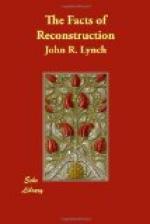At the conclusion of this conference I made public announcement of the fact that, since it was my purpose to become a candidate for Congress in the Sixth or “shoe-string district,” I would not be a candidate for delegate to the National Convention but would give my support to Bruce and Hill, for two of the four places on the delegation from the State at large, with the understanding that the delegation, if controlled by them, would not be hostile to Grant. I had reasons to know that Mr. Bruce, in consequence of his cordial relations with Senator Conkling,—the national leader of the Grant forces,—was not unfriendly to Grant, and that he would use his influence to prevent the delegation from going into any combination for the sole purpose of defeating the nomination of Grant. In other words, Grant was Brace’s second choice for the nomination.
The fight for the delegation was waged with a good deal of heat and bitterness. The canvass had not progressed very far before it was developed that Grant was much stronger than the faction by which he was being supported. The fight was so bitter, and the delegates to the State Convention were so evenly divided, that the result was the election of a compromise delegation which was about evenly divided between Grant and Sherman. Bruce and Hill were among those that were elected.
The National Convention, which was held in Chicago in June of that year, was one of the most exciting and interesting in the history of the party. It was that convention that abolished what was known as “the unit rule.” Up to that time the right of a State Convention to elect all the delegates to which the State was entitled,—district as well as State,—and to instruct them as a body had never before been questioned. New York, as well as other States, had instructed the delegates to cast the entire vote of the State for Grant. This was the unit rule. It is a rule which even now is enforced in National Conventions of the Democratic party. It was through the enforcement of this rule that Mr. Cleveland was renominated, when he was so bitterly opposed by a portion of the delegation from his own State,—especially the Tammany delegates,—that General Bragg was moved to make the celebrated declaration that he “loved Mr. Cleveland on account of the enemies he had made.” Notwithstanding the fact that those delegates were strongly opposed to Mr. Cleveland, and though they protested against having their votes recorded for him, they were so recorded through the application and enforcement of the unit rule. It was the enforcement of this rule upon which Mr. Conkling insisted in the National Republican Convention of 1880. About twenty of the New York district delegates, under the leadership of Judge W.H. Robertson, refused to be governed by the instructions of the State Convention. Their contention was that the State Convention had no right to bind by instructions any delegates except the four from the State at large. After a lengthy and heated debate the convention finally sustained this contention, and since that time the unit rule has not been recognized in a National Republican Convention.




